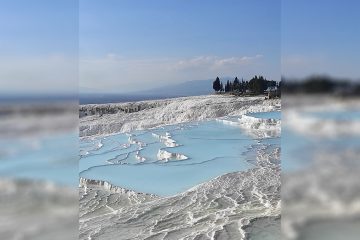Explore Gallipoli and Anatolia
We will begin to visit firstly uniqueness of Cappadocia region lies on a wide plateau, formed by the lava flows and ash from the eruptions of the now extinct volcanoes Erciyes, Melendiz and Hasan Mountains in the region. The area has remarkable rock formations, with churches carved into odd-shaped rocks, and is one of the most popular tourist destinations in Turkey. There are more than 220 churches, most of which are located in the Cappadocia area. We pass to Aegean region, the shores of the region are among the loveliest landscape in the country. The magnificent coastline, lapped by the clear water of Aegean Sea, abounds in vast and pristine beaches surrounded by olive groves, rocky crags and pine woods. We visit the rockpools of Pamukkale, archeologically ruins of Ephesus, continue northwards we visit ancient Troy, a 5000 years old legend. We pass to Marmara region and visit Istanbul is the only city in the world which embraces two continents, one arm reaching out into Asia, the other into Europe. The museum, churches, places, mosques and bazaars and the sight of natural beauty seem inexhaustible. As you recline on the shores of the Bosphorus at sunset contemplating the red evening light reflected in the windows and on the slender minarets on the opposite shore you understand, suddenly and profoundly, why so many centuries ago settlers chose to build on this remarkable site.
Itinerary 14 days:
Day 1 : Kayseri
Meet the group at the airport and transfer to the hotel. Drive to Cappadocia. Overnight hotel in Cappadocia.
Day 2. Visit to Uchisar – Goreme Open-air Museum – Kaymaklı Underground City
We spend most of the day visiting the major points of historical and topographical interest, including Uchisar and Goreme. Goreme lies at the foot of three extinct volcanoes. Centuries ago, volcanic eruptions covered the Goreme valley with mud, ash and sometimes with blocks of hard rock. Over the ages this volcanic tufa was sculpted by erosion into strange and improbable shapes; cones, needles of stone, pyramids of soft stone – some 30m high. Into this remote spot came the Byzantine hermits, who carved churches, houses, fortresses and even complete underground cities into the cones. Entire troglodite villages and subterranean churches are hewn out of the soft volcanic rock and make the whole place a spectacular sight to behold. We shall wonder at the ‘fairy chimneys’ – tall needles of stone with rocks perched on top, caused by erosion, which fill entire valleys. Goreme contains the area’s largest concentration of rock carved churches. We will also visit the underground city at Kaymakli, built by Christians escaping Arab oppression. More of this incredible underground maze of catacombs is being discovered every year.
Day 3 : Cappadocia – Ihlara valley – Konya
In the morning we drive to Ihlara valley , was once the favourite retreat of Byzantine monks. This valley was formed by primeval earthquakes and the was once rushing river is now a quiet stream. There are many rock-cut churches is with well preserved frescos dating from the 9th century. Wosmanse drive to visit 13th century Agzikarahan caravanserai , The gate is a fine example of Selcuk architecture and is a reminder that we are travelling one of the ancient caravan routes linking Asia to Europe. We continue the transfer to Konya was capital of Seljuk empire from 12th to 13th centuries. Konya is a city for its works of Seljuk art and architecture and for its tomb of 13th century poet and philosopher Mevlana Celaleddin Rumi , founded a Sufi order known in the west as the Whirling Dervishes. After visiting of Mevlana we can visit Alaeddin Mosque was built the great Seljuk sultan Alaeddin Keykubat. Overnight at hotel
Day 4 : Konya – Antalya
In the morning drive to Antalya. On the way we stop to visit Aspendos theatre ,the ruins of this city are Roman, with the exception of the bridge over the river Eurymedon which dates from the Selçuk period. Arrive to Antalya principal holiday resort of Turkey at the Mediterranean sea , is an attractive city with shady palm-lined boulevards. Kaleici where we will stay is narrow, winding streets and old wooded houses abut the ancient city walls. We visit Yivli minaret (fluted minaret) located in centre of Antalya,, is minaret of Alaadin mosque converted from a church in 7230 by Seljuk Sultan alaadin Keykubat. Rising like a monument is symbol of Antalya. Overnight hotel
Day 5 : Antalya – Kayakoy (ghost town)- Dalyan
We drive to Kayakoy to explore the uninhabited town of Kaya, the largest Greek ghost town in Asia Minor. After the foundation of Turkish republic, the governments of Turkey and Greece chanced the population. After visiting of the monuments And then we arrive to Oludeniz, its beach takes its eerie name from the secluded lagoon at the beach’s western end. Protected by hills and entered by a narrow channel, the lagoon is calm during even the worst storms. From here transfer to Fethiye, some 2400 years ago, Fethiye (FET-hee-yeh) was the prominent town of Telmessos, but earthquakes have left only a few Lycian stone sarcophagi from the old town, along with the dramatic Tomb of Amyntas carved into the sheer rock cliff high above the town. after visit we drive to Dalyan.. Overnight hotel
Day 6 : visit Caunus- river boat tour – Dalyan
Dalyan, a small canoe will take us other side of the river where the ancient civilisations of Caunus were known for their sickness and poor health. Despite its unhealthy reputation, Caunus went through a long series of different cultures. The extensive ruins include a huge Roman Bath, Persian City walks, a Carian fortress, a Greek theatre and a Byzantine basilica. After visit Caunus city we board our river boat and sail to the hot spring by waterway, opportunity to swim in the amenaged natural swimming pools (hot spring) and opportunity for mud bath. Overnight hotel in Dalyan
Day 7 : Dalyan – Pamukkale
In the morning we will drive to Pamukkale that known ancient Hierapolis. We visit Pamukkale travertines that the formations look almost unreal. The rich calcium content of the mineral water from the nearby thermal springs. In other words, the lime residue, after the carbon gas evaporates, create the visual miracles, the travertines and the pools on the top of each other. We may walk on the travertine with barefoot. Overnight hotel
Day 8 : Pamukkale – Aphrodisiaa – Ephese
In the morning we visit Aphrodisiacs that developed during the period of the Romans. Aphrodisias is unquestionably one of the most impressing ancient cities of Anatolia with its well-preserved buildings and numbers of magnificent sculptures from the Roman period. Being built near a marble quarry, the city was also an important center in the past with its famous sculpture school and for being one of the several cities that was dedicated to Aphrodite, the goddess of love.. Overnight hotel.
Day 9: Ephese
In the morning we visit Ephese was an important port city until with passing of time and erosion. The city, whose wealth and patronage supported its splendid architectural program, was dedicated to the goddess Artemis. The ruins also include a theatre, gymnasium, agora and baths, as well as the Library of Celsus. We also visit house of Mary (meryem ana evi), we know that St. John spent the last years of his life in Epheus and wrote his Gospel here. Jesus left his mother with John, therefore, it is believed that Mother Mary came to Epheus and lived here until the end of her life
Day 10 : Ephese – Pergamum
In the morning we will drive to Pergamum, is once great centre of culture, survives as one of Turkey’s finest archaeological sites. In the Acropolis, above the modern town, are the remains of the celebrated library, a steep and impressive theatre, the temples of Trijan and Dionysus, the monumental altar of Zeus, the sanctuary of Demeter, a gymnasium laid out on the terrace and Agora. Overnight hotel
Day 11 : Pergamum – Troy – Canakkale
In the morning we drive to Canakkale. we visit Troy, Archaeological excavations have revealed nine separate periods of settlement including ruins of city walls, house foundations, a temple and a theatre. A symbolic wooden Trojan horse commemorates the legendary war. After visiting we drive to Canakkale lies at the narrow 1200 m. Entrance to the Strait of Dardanelles that connects the sea of Marmara and the Aegean. Overnight at hotel.
Day 12 : Canakkale – Istanbul
In the morning we will boars one of the ferryboat and pass through Dardanelles. Arriving to Istanbul is the only city in the world which embraces two continents, one arm reaching out into Asia, the other into Europe. Considered as a leading metropolis in the world, for culture, arts, history, trade and business. Overnight hotel
Day 13 : Istanbul
We’ll visit on foot the Sultanahmet Square. Also known as the Hippodrome of Constantinople, the square was used for chariot racing in the Roman era. Today it’s much more sedate but houses iconic landmarks such as the Byzantines, the Serpentine Column, Obelisk of Theodosius and the Walled Obelisk. We’ll have a guided tour of the square, ending at its most famous building, the Sultanahmet Blue Mosque. Continuing the visit for Suleymaniye Mosque, an imperial mosque commissioned by Suleiman the Magnificent in the mid 1550s.This afternoon, we’ll take the public ferry across the Bosphorus to Kadikoy. Taking around thirty minutes, the ferry offers great views of the city skyline from the waterway that separates the continent of Europe and Asia. The Asian side of Istanbul is full of lively cafes, bars, shops and galleries, it is less touristed and more residential and offers a view of another side to the city. After Exploring the neighbourhood on foot, we will return by ferry.
Day 14 : Istanbul – home
In the morning transfer to the airport and fly home.











Tour Reviews
There are no reviews yet.
Leave a Review